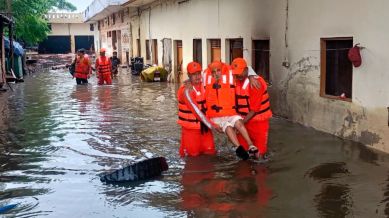Stay updated with the latest - Click here to follow us on Instagram
Floods fiasco: Punjab govt spent just 17 days to prep for rains
The delayed preparation, ignored NHAI plan, faulty gates expose governance gaps

Seventeen days. That’s all the Punjab government had to prepare for monsoon after holding its first flood-preparedness meeting on June 5. Barely three weeks later, the southwest monsoon hit the state on June 22. With four major rivers — Sutlej, Beas, Ravi, and Ghaggar — in spate, over 1,100 villages inundated, and 12,000 people displaced, questions mount on why the state ignored early warnings despite flood devastation in 2023.
The government released Rs 117 crore for repair of 2,800 km of dhussi bandhs and cleaning of drains across 23 districts, but the timeline was unworkable. “It takes time to release funds even after the CM clears it. The June 30 deadline was unrealistic,” admitted a senior official.
monthly limit of free stories.
with an Express account.
A retired Punjab government official told The Indian Express that during his tenure, flood control meetings were held in February and March to allow sufficient time for preparations.
“This time, the meteorological department had issued warnings of heavy rain, but the government ignored them. This happened despite the state having faced floods just two years ago, in 2023,” he said.
In February, Aam Aadmi Party (AAP) leaders were busy with Delhi Assembly elections, so no meeting was convened then. When the meeting was finally held in June, the state was left with very little time to prepare, especially given that it has four major rivers: Sutlej, Beas, Ravi, and Ghaggar.
Former irrigation minister Janmeja Singh Sekhon, who handled the portfolio during the SAD-BJP regime (1997-2002, 2007-2014), minced no words: “During Parkash Singh Badal’s tenure, meetings were held in April or May. Once, when heavy rain was predicted, he even called it in February. Funds were released at the start of the financial year and all works had to be finished by June 30—well before the rivers swelled. Badal sahib wouldn’t let us sleep before or during monsoon. He would send me to check weak studs, dhussi bandhs, and drains. This government is visible only when under fire.”
Revealing what he called a “shocking lapse”, Sekhon alleged that at Madhopur headworks, only 4 out of 28 gates were operational. “They hadn’t been serviced. Badal sahib considered gate maintenance so crucial he would stop salaries to fund it.”
Former Congress water resources minister Sukhbinder Singh Sarkaria pointed to systemic instability. “They changed three ministers in charge. It took me 6-8 months to understand the system. Earlier, meetings were chaired by the CM in February with all DCs present. We released Rs 100 crore, and it was enough. Today, they claim Rs 200 crore spent, but I don’t see any work. They blame BBMB for dam releases, but Ranjit Sagar and Pong dams are under state control. Water should have been released earlier to reduce damage by at least 50%.”
AAP MP and environmentalist Balbir Singh Seechewal, who’s been present at the site of floods ever since the water invaded areas in Kapurthala, blamed lack of de-silting for the overflowing rivers.
“Harike headworks has not been desilted even once since it was built. I have reminded every government. The reduced capacity floods low-lying areas every year,” fumed Seechewal.
A former irrigation officer revealed a missed opportunity. He said the National Highways Authority of India (NHAI) had asked for silt from rivers for their road projects to raise highways by 10 feet but was refused. “This would have helped desilt rivers well before monsoon and earned revenue for the state. But the government refused, citing a High Court stay. Even when it rained in July, they sought another stay instead of convincing the court that desilting was critical.”
The Madhopur headworks fiasco further exposed governance gaps. Former chief engineer Amarjit Singh Dullet said the government paid Rs 23 lakh to a private company for a report instead of trusting its own structural engineers, the same people who designed Ranjit Sagar and Shahpur Kandi dams. “Why ignore in-house expertise,” he asked.
Dullet added, “They may have released Rs 117 crore, but no work was visible. On Ghaggar, nothing was done. On Pong dam, Ujh, and Ravi, everything was left to God. Engineers are inexperienced and need training. This was ignorance, not negligence but the result is the same.”
Water resources minister Barinder Kumar Goyal dismissed the allegations saying they released Rs 117 crore and completed the repairs. “The rains were unprecedented. The meeting was held well on time, floods began in August. There was no breach in dhussi bandhs; they overflowed because there was too much water. On Madhopur, we have issued a show-cause notice to the company.”
An irrigation department engineer, who requested anonymity, blamed the floods on rivers changing their course. “Even if Rs 2,000 crore were given, it would not be enough for dhussi bandhs. Rivers are dynamic; they change their courses. Then there are other challenges.”
As Punjab battles devastation, one fact stands out: floods were not a surprise, but preparedness was missing.